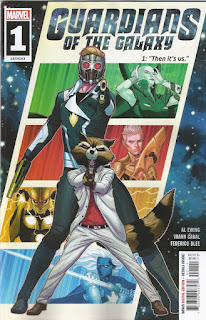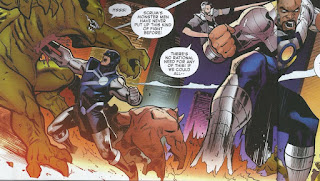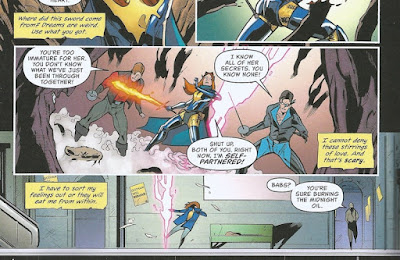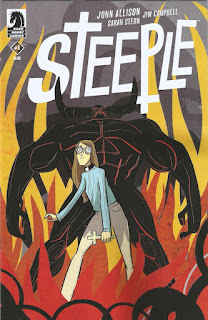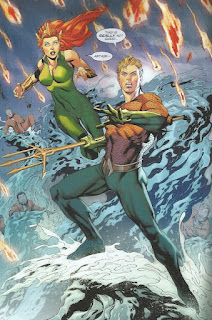Pick of the Brown Bag
January 22, 2020
by
Ray Tate
Welcome to the Pick of the Brown Bag, in this blog, I review the best and worst comic books of the week. I may also have a few words for the also-rans.
For the record, the length of the passage isn't indicative of the book's quality. I try not to spoil important information. So, sometimes the critique of an incredibly good book, Far Sector for instance, can be remarkably short if enough surprises or clues to a mystery present.
Remember if you haven’t the time for the full-length blog, you can pop over to Twitter for short sentences. #PickoftheBrownBag.
This week I examine Batgirl, Captain Marvel, Detective Comics, Fantastic Four, Guardians of the Galaxy, Red Sonja and the Age of Chaos, Red Hood and the Outlaws, Spider-Man and the Black Cat, Vampire State Building and Vampirella.
The Gods of Marvel Comics are crazy. They raze worlds to prepare for a new beginning. At least, that's what I think is going on.
Honestly, I'd peg the whole thing as a giant, lethal con if not for the floating city that serves as the home for oodles of Greek Gods including a juiced up Artemis and Hermes.
Richard Ryder the Man Called Nova attempts to recruit a team of super-powers to stop the Slaughter of the Gods. Naturally, he goes to his old friends the Guardians of the Galaxy.
Juan Cabal wowed me on Elektra, and his artwork sings in Guardians of the Galaxy. Unfortunately, writer Al Ewing can do a lot better than this. Ewing re-energized The Hulk. He brought trickster inspired humor to Loki. He blended drama and comedy in The Ultimates. Guardians of the Galaxy? Bland, I'm afraid. It doesn’t help matters that Ewing bases his book in Marvel’s increasingly difficult to comprehend cosmic continuity.
Sorry. I don’t speak Cancerverse. I also cannot fathom how it pertains to whatever the heck happened to the Olympian Gods. A more important question. What happened to the Guardians of the Galaxy?
I’ll bet this is when he goes all historic.
Yeah, okay. We don’t have to go that far back. Let’s just stick to the Marvel cinematic universe that made the Guardians relevant again.
Surprisingly, those Guardians all sign in. With the exception of Drax, they've changed. Rocket isn't Rocket unless he's trying to blow something up or shoot at something.
Peter Quill and Gamora are a couple, but they’re boring.
This is a huge disappointment. If Quill and Gamora ever got together, I expected at least a little spice. Their placidness however is not the tantamount sin.
Gamora eschewing a fight is antithetical to her characterization.
The story thus centers on Peter and a pensive Rocket joining lesser Kree-Based heroes on the mission to stop the Olympians and their wave of destruction.
I’m falling asleep.
Reed and Johnny decided to rebuild the rocket that first took the quartet into space. The rocket hit by cosmic rays that reacted with their genomes to evolve the Fantastic Four. This time there would be better shielding. This time they would prove their initial calculations correct.
After convincing Ben Grimm to rejoin them, the FF blast off smooth and perfect. Except, they find themselves on the planet Spyre. Its Overseer predicted the FF would destroy them.
To counter the possibility, the Overseer subjected his people to cosmic radiation thereby mutating some into heroes and others into monsters.
Through a sequence of events, the FF discover an even darker secret.
Dan Slott’s story started out slow but steadily picked up steam. With the revelations in this issue, the tale seethes. Slott elegantly adds to the weight of the FF’s origin. At the same time he keeps things light through the characterization and the oddball social structure of the planet that's paired Johnny Storm with Spyre hero Sky.
For no apparent reason, Captain Marvel attacks Thor and then in the next issue Iron Man. Worse, she seems to be killing our heroes. She’s not. She’s buying time because a villain called Vox Supreme forced her into the execution business.
Captain Marvel revisited a SHIELD base that stored cloned Avengers. She’s been using the bodies as proof of her kills.
At the same time, Carol disappeared the Avengers into Singularity. Literally a living dimension introduced in writer Kelly Thompson’s highly recommended A-Force.
This issue of Captain Marvel offers a big boost away from the simple fight mentality of the opening chapters. Thompson generates more interaction between Carol Danvers and the secreted Avengers. Comedy arises from the dialogue, with Thor sounding verily like Chris Hemsworth.
She better explains Carol's no-win situation. She also surprises by defying the cover depiction by pitting Carol against an unannounced teammate. She-Hulk in fact doesn’t appear until the conclusion.
Batgirl’s latest foray is an improvement over the Oracle debacle, but it’s still far from good. The betterment lies in the nature of the beast.
Writer Cecil Castellucci revisits plot elements from Dan Abnett’s consistently superb Titans.
Castellucci botches the Unearth, the characterization Ernest Hinton the author/creator of the Unearth and much, much more, but at the very least, Batgirl isn’t remotely connected to the fiasco. As I expounded in past reviews of Batgirl Babs never engineered the Oracle robot, but here, there’s not even a pretense.
Nice stab at distracting me with Babs in a bubble bath, but no. Castellucci still hasn't a clue on how to write Batgirl. Observe this poor romance novel even dialogue.
First and foremost, there are two schools of thought on the Dick Grayson/Barbara Gordon thing. There are shippers, and there are people like me who can sum this up with two words. Fuck you. That applies doubly so for Jason Bard, who framed Babs' Dad in order to take his place because he intended to kill Batman. New 52 Jason Bard, asshole villain. Second, and this is an important point. Dick Grayson's not dead. He's just screwy in the head.
Her eyes are even blue in Nightwing
Babs' chance for romance with Dick Grayson, something she denies in Nightwing ended when Dick became Rick Grayson thanks to post-regenerative amnesia. That nevertheless doesn't stop Castellucci from making this the focus of the story.
Will it be Jason, will it be Grayson? It's a wonder why she doesn't break out into song. Even when she seems to be self-affirming, Babs' narration betrays her. This is just awful writing. Babs Gordon doesn't behave this way. Her focus should be on defeating the conjured creatures and rescuing the kidnaped.
The Unearth is a fictional realm imagined by its author Ernest Hinton, given substance by a meta-gene. For those not in the know, the meta-gene is DC’s answer to mutant genes that grant superpowers.
Castellucci uses the Unearth as a ham-fistedly conveyed feminist message about men controlling women or men contouring women to their liking. The problem for me is that Ernest wasn’t that guy.
He was a harmless fantasy writer who unfortunately or fortunately depending on your viewpoint found a means to bring his literal fantasies to life. Mostly subconsciously. As the Unearth denizens sought their creator. He was unaware that his creations existed.
Batgirl fails on so many fronts. However, there are two successes to its name. Cian Tormey. This artist draws the hell out of Batgirl.
He or she gives her muscle. He grants her a mien despite being hamstrung by an idiot-designed costume. Tormey in fact makes some adjustments to her costume. The cowl is fuller. The cape scalloped. The ears sharper and taller. He also matures her face, chipping it with angles and presenting a determination that surpasses the self-deprecation Castellucci seems to enjoy writing. Colorist Chris Sotomeyer furthermore lightens the gray unitard and coneys the illusion of a slick texture that shows off Babs' sinew. He darkens the blues and blackens the cape to complement its leathery length. Overall, this is a superior visual issue of Batgirl. Just don't read it.
As you can see, a cult sets Batman afire on the cover of Detective Comics. Obviously, they recognize him as a scientist. Nevertheless, this scene does not occur. The rituals are far more gruesome.
Writer Peter Tomasi goes out of his way to make certain the reader understands that Batman can compartmentalize his feelings. He dispassionately investigates the series of ritualistic murders and arrives at the “however improbable.” Like Sherlock Holmes, when he confronts the killers he can release his emotions, aiming at an appropriate target.
Holmes and the Shadow recognized Batman as their legitimate successor. This has never been more true when a mystery goes completely off the rails.
Holmes had his Creeping Man. The Shadow routinely dealt with the bizarre but grounded in rational explanations. Batman must contend with things that Holmes and the Shadow could not possibly imagine. In fact, in that last panel. Batman is thinking to himself WTF. Batman and the reader are for once on the same page.
Last week I drew parallels between Aquaman and The Naked Jungle. The review is down below, or embedded in the next set, when clicking on older posts. Essentially, it comes down to this. Every terrible movie can be better with Army Ants. Just think how good Cimarron might have been with Army Ants eating Glenn Ford’s smug bastard Yancey Cravat alive. No, seriously. His name was Yancey Cravat. Detective Comics is the opposite. It’s John Wick, only with Army Ants.
The cover to Red Hood and the Outlaws emphasizes the relationship between Jason Todd and Artemis, or better still if there's a chance for one. There's a good quarter of the book dedicated to that, but writer Scott Lobdell takes it from Jason's point of view. So the romance aspect sounds like its being related by a hard-boiled private eye, which is how Lobdell always characterized Jason. Thus, accurate.
Lobdell characterizes Artemis like she's an Amazon. The Amazons of the DCU that is. She's a fierce warrior, but the Amazons appreciate beauty in all things. They furthermore express their emotions freely. They have no repression. Lobdell presents this in Artemis' empathy toward Jason when he tells her about the death of Roy Harper. Artist Paulo Pantelena and colorist Arif Prianto just nail this emotive scene.
That's just a taste of nine panels and one splash page. The talent also draw attention to Bizarro. Lobdell's Bizarro is perhaps the most complex of the imperfect Superman clones. In this issue of Red Hood we sample his meditative, at peace with the world side. Once again you expect nothing from DC's answer to Guardians of the Galaxy and gain so much more more.
Spider-Man and the Black Cat is a game tie-in. So writer Dennis Hopeless can take some liberty like depicting Mary Jane Watson as Overwatch.
Of course, that may be her role in the game as well, but I never played. So, i wouldn't know.
The crime fighting duo interrupt an attempted art heist courtesy of Tombstone's gangster goons. This gives artist Luca Maresca and Rachelle Rosenberg the opportunity to strut their stuff.
Black Cat shows up with a sneaky plan worthy of the character. As with continuity proper, she's Spidey's ex, but don't worry, you haven't missed an issue of the Gameverse. Their present day encounter leads to a flashback to the time Spider and Cat took on King. Pin that is.
Black Cat is almost as visually dynamic and personality attractive as she is in Jed McCay's book. An excellent variation on the relationships.
Red Sonja and the Age of Chaos is a brisk adventure that’s fueled by Sonja’s perpetual duel with Kulan Gath.
That's The Black Terror's Jonathan Lau turning Sonja from bombshell chainmail-bikinied babe into get the hell out of my sight samurai styled warrior.
The lion’s share of the issue however is dedicated to Chaos Publishing. I was never interested in the Chaos figures, as they were mostly villains. I’m aware of their look thanks to advertising and Previews.
If you haven’t a clue about the Chaos pantheon, don’t worry, writer Erik Burnham painlessly introduces them to you.
Okay. Vicious woman that drinks blood. I'll take Vampires for four hundred, Alex. Certain aspects of each antagonist becomes digestible as you read.
Evil Ernie has a talking button companion. Weird, but interesting.
The story begins when the Chaos version of Death Incarnate cons each of the Chaos conclave to vie for Kulan Gath’s fetching necklace. Of course, you know what that means.
Possession is nine-tenths of the law. Evil beings possessing or being possessed by Kulan Gath’s jewelry results in bad news.
Vampirella accompanies “witch boy” Benny to a nude beach for relatively funny dialogue but little in the realm of plot development.
Meanwhile Vampirella’s lover Victory confronts Mary, a member of the monster-hunting nuns, whose got it bad for Vee. A new threat arises from deep in the heart of vampire country, as writer Christopher Priest sets up the interlude to the main event. Kind of dull with a few sparks of wit.
Vampire State Building concludes with some pyrotechnics and a few hide and go seek gymnastics. Seriously though, for the most part Vampire State Building has been a treat. It’s more visually appealing, rather than breaking any new ground in vampire mythology. That said. The vampires are more of a horde mentality rather than cunning, urbane bastards. Writers Ange and Patrick Renault offers a few new twists, in previous issues, but the entirety I think will read better as a trade paperback and would work well as a movie.
